
Bengo is a province of Angola. Its capital is Caxito. It has an area of 31,371 square kilometres, and its population as of the 2014 Census was 356,641. The province was created in 1980 by dividing the original province of Luanda into Bengo and a new smaller province of Luanda.

Globidens is an extinct genus of mosasaurid oceanic lizard classified as part of the Globidensini tribe in the Mosasaurinae subfamily. Globidens belongs to the family Mosasauridae, which consists of several genera of predatory marine lizards of various sizes that were prevalent during the Late Cretaceous. Specimens of Globidens have been discovered in Angola, Brazil, Morocco, Syria and the United States. Among mosasaurs, Globidens is probably most well known for the highly rounded, globe-like teeth that give it its name.
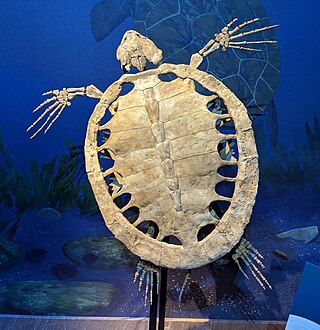
Euclastes is an extinct genus of sea turtles that survived the Cretaceous–Paleogene mass extinction. The genus was first named by Edward Drinker Cope in 1867, and contains three species. E. hutchisoni, was named in 2003 but has since been reassigned to the genus Pacifichelys, while E. coahuilaensis named in 2009 was reassigned as Mexichelys coahuilaensis in 2010.
Igdamanosaurus, meaning "lizard from Igdaman", is an extinct genus of Cretaceous marine lizard belonging to the mosasaur family. It is classified as part of the Globidensini tribe, and is like the other members of the tribe recognised by its rounded and knob-like teeth. These teeth indicate a highly specialized lifestyle, likely including a durophagous diet.

Angolasaurus is an extinct genus of mosasaur. Definite remains from this genus have been recovered from the Turonian and Coniacian of Angola, and possibly the Coniacian of the United States, the Turonian of Brazil, and the Maastrichtian of Niger. While at one point considered a species of Platecarpus, recent phylogenetic analyses have placed it between the (then) plioplatecarpines Ectenosaurus and Selmasaurus, maintaining a basal position within the plioplatecarpinae.

Crocodyliformes is a clade of crurotarsan archosaurs, the group often traditionally referred to as "crocodilians". They are the first members of Crocodylomorpha to possess many of the features that define later relatives. They are the only pseudosuchians to survive the K-Pg extinction event.

Angolatitan is a genus of titanosauriform sauropod dinosaur from the Upper Cretaceous. It is also the first non-avian dinosaur discovered in Angola. The genus contains a single species, Angolatitan adamastor, known from a partial right forelimb. Angolatitan was a relict form of its time; it was a Late Cretaceous basal titanosauriform, when more derived titanosaurs were far more common.

The geology of Angola includes large areas of Precambrian age rocks. The west of the country is characterized by meta-sedimentary rocks of Proterozoic age including tillites assigned to the Bembe System. Overlying these are a thick pile of limestones and other marine sediments laid down during the Mesozoic and Cenozoic eras. Amidst the Proterozoic sequence are areas of crystalline basement dating from the Archaean. More Archaean basement rocks form the Kasai Craton in northeastern Angola. In the north, within the Cassanje Graben are clastic sediments and volcanic rocks of the Karoo Supergroup. Kimberlites and carbonatites resulting from magmatic activity during the Karoo period are found along a northeast-southwest line through the country. Continental sediments of the Kalahari Group are widespread in eastern Angola.
The Bentiaba is a river in southern Angola. Its mouth is at the Atlantic Ocean near the commune of Bentiaba in Namibe Province.

Cardiocorax is an extinct genus of elasmosaurid known from the Late Cretaceous Mocuio Formation of Namibe Province, southern Angola. It contains a single species, Cardiocorax mukulu.

The Globidensini or Globidentatini are a tribe of mosasaurine mosasaurs, a diverse group of Late Cretaceous marine squamates. Members of the tribe, known as "globidensins" or "globidensine mosasaurs", have been recovered from North America, Europe, Africa and Asia. The tribe contains the genera Globidens, Carinodens, Igdamanosaurus, Harranasaurus and Xenodens. Features of the maxilla and digits make the placement of Carinodens and Xenodens in the tribe uncertain; some researchers have suggested that they may be more appropriately placed in the Mosasaurini.

Alcione is a genus of pterosaur from the Ouled Abdoun Basin of Morocco, dating back to the Maastrichtian stage of the Late Cretaceous period. Only one species, A. elainus, is known. This pterosaur lived in a marine environment alongside several other pterosaurs, including Simurghia and Barbaridactylus.
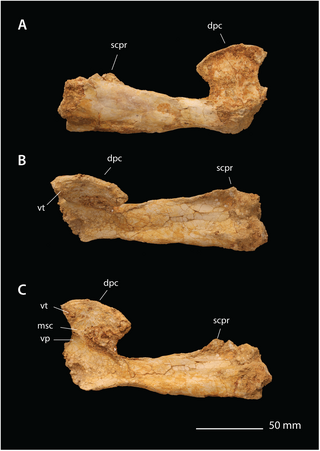
Simurghia is a genus of pterosaur from the Ouled Abdoun Basin of Morocco, a basin that dates to the Maastrichtian stage of the Late Cretaceous period, about 66 million years ago. It was published in 2018 by paleontologists Nicholas R. Longrich, David M. Martill, and Brian Andres, along with two other pterosaurs from the same basin: Alcione and Barbaridactylus. The type species is S. robusta. A possible second species, S. ("Nyctosaurus") lamegoi, is known from the Campanian-Maastrichtian age strata of Brazil.
The Itombe Formation is a geological formation of the Kwanza Basin in Angola dated to the Coniacian stage of the Late Cretaceous. The environment of deposition is shallow marine. Reptile fossils have been recovered from the Tadi beds locality within the formation, including the dinosaur Angolatitan, the mosasaurs Angolasaurus and Mosasaurus iembeensis and the turtle Angolachelys. The Itombe formation was formerly considered Turonian in age, but new data suggests to be Coniacian.
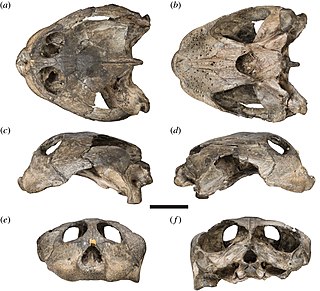
Sandownidae is a family of extinct marine turtles from the Cretaceous and Paleogene distributed around the Atlantic Ocean and adjacent areas. The family is defined as all taxa closer to the type genus Sandownia than to Pelomedusa, Testudo, Solnhofia, Eurysternum, Plesiochelys, Thalassemys or Protostega, a definition that encompasses the previous concept of the clade while also excluding it from being synonymous with other clades of modern or extinct marine turtles. Sandownidae may be within the larger clade Angolachelonia, defined as inclusive of Angolachelys and Solnhofia, sister to the entirely Late Jurassic marine group Thalassochelydia, although the concepts of the clades may shift with further phylogenetic analysis.
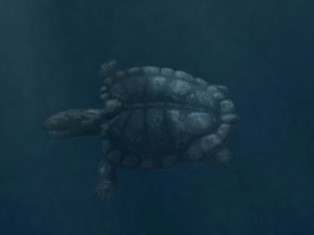
Angolachelonia is a clade of extinct turtles from the Late Jurassic to Paleogene of Eurasia. The group is defined as all taxa derived from the ancestor of the type genus Angolachelys and Solnhofia, a definition that could potentially encompass a clade of entirely marine turtles. Angolachelonia was originally inclusive of only Solnhofia, Angolachelys and Sandownia when originally conceived by Octavio Mateus and colleagues in 2009, but later phylogenetic analyses by Serjocha Evers and Roger Benson in 2018 unites the family Sandownidae, including Angolachelys and Sandownia among other taxa, with the entirely Late Jurassic clade Thalassochelydia, where Solnhofia may be a basal member. While the placement of Solnhofia is weak and the clade that Angolachelonia represents may change with further analysis, the clade of Sandownidae and Thalassochelydia is well-supported, and does not collapse despite the uncertain evolutionary history of the group. Three alternative potential origins of Angolachelonia sensu Evers and Benson are shown below.
Calcarichelys is an extinct genus of protostegid turtle from the Late Cretaceous of the Selma Formation in Alabama, and possibly from Angola. It contains only one species, C. gemma.
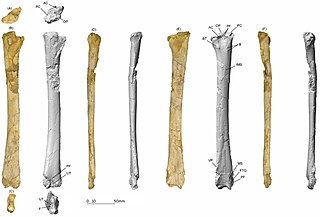
Epapatelo is a genus of pteranodontian pterosaur from the late Cretaceous Mocuio Formation of Namibe Province, Angola. The genus contains a single species, E. otyikokolo, known from partial left limb bones.
The Mocuio Formation is a Late Cretaceous sedimentary rock formation found in southern Angola. It extends from the latest Campanian to the Early Maastrichtian. Many vertebrate fossils have been collected from the formation.


















